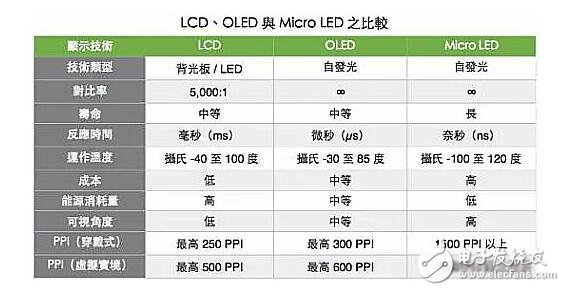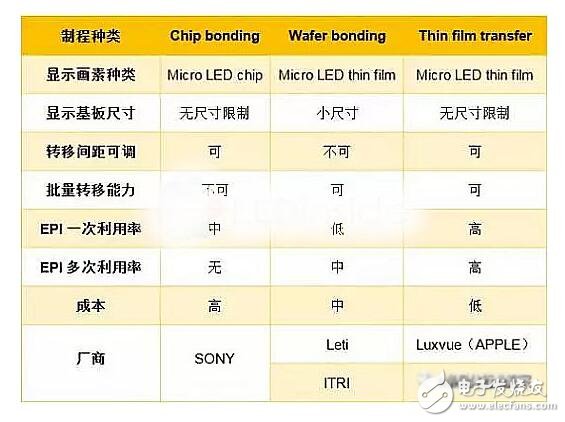In the 10-year mobile phone launched this fall, Apple will use organic screen (OLED) for the first time in the company's history, supplied by Samsung Display. However, according to foreign media reports, Apple also acquired a company with micro-LED display technology, and is engaged in the research and development of display panels, which has caused certain concerns for Samsung, LG and other screen manufacturers.
According to the US technology news website Apple Insider, Apple will start producing micro-LED displays later this year, which will be used in the third generation of Apple watches. Currently, organic screens are used in Apple watches.
In the field of display panels, Apple has no technical reserves in the past. However, in 2014, Apple acquired a company called LuxVue, which acquired the company's micro-LED technology. In the past few years, this display panel technology has begun to attract industry attention, and Apple is also actively engaged. Development.
Micro-LED is optimistic as a new generation of display technologyIn addition to liquid crystals, organic screens are considered as an alternative to liquid crystal panels. Before Apple, many mobile phone manufacturers such as Samsung Electronics have begun to use organic screens, which have better screen quality, more power saving, thinner thickness and curved design.
In fact, organic screen technology has been around for many years, but its cost is difficult to decline, but in the past few years, organic screen mass production technology has achieved breakthroughs, which has lowered costs. A large number of organic screen mobile phones and TV sets have appeared in the market, and there will be more related manufacturers in the future.
Micro LED Display is a new generation of display technology. The structure is miniaturized LED array, which is to thin, miniaturize and array the LED structure design, so that its volume is about the current mainstream LED size. At 1%, each pixel can be addressed and individually driven to illuminate, reducing the distance of the pixel from the original millimeter to the micrometer.

Inheriting the characteristics of LEDs, Micro LEDs include low power consumption, high brightness, ultra high resolution and color saturation, fast response speed, ultra power saving, long life, high efficiency, etc. The power consumption is about LCD. 10%, 50% of OLED. Compared with the OLED, which is also self-luminous display, the brightness is 30 times higher than the OLED, and the resolution is up to 1500 PPI (pixel density), which is equivalent to 5 times that of the Apple Watch using OLED panels up to 300 PPI. Better material stability and imageless imprinting are also one of the advantages.
The large size is the cost competition, and the competitive advantage of Micro-LED is not obvious. Micro-LEDs have great challenges in terms of large size. For many years, compared with LCD and OLED, LEDs have no advantage in cost, and from the actual investment and progress of Micro-LED, Micro-LED has no influence. Imagine that big. LCD has low cost, stable yield and strong competitiveness. Just like the LCD and PDP, the future competition between LCD and Micro-LED is not solely related to the competition of technology, but also involves the industry chain and ecological competition.
Process type and technology developmentThe process shrinkage for semiconductors and chips has reached its limit, and there is still considerable room for growth in manufacturing miniaturization. For the Micro LED process, there are currently three main types: Chip bonding, Wafer bonding, and Thin film. Transfer.

Chip bonding
The LEDs are directly cut into micron-sized Micro LED chips (including epitaxial films and substrates), and micron-sized Micro LED chips are bonded to the display substrate one by one by SMT technology or COB technology.
Wafer bonding
Inductively coupled plasma ion etching (ICP) on the epitaxial film layer of the LED directly forms a micron-scale Micro-LED epitaxial film structure. The fixed pitch of the structure is the spacing required to display the gradation, and then the LED crystal The circle (including the epitaxial layer and the substrate) is directly bonded to the driving circuit substrate, and finally the substrate is peeled off by physical or chemical mechanism, and only the micro-LED epitaxial film structure of 4 to 5 μm is formed on the driving circuit substrate to form a display.
Thin film transfer
The LED substrate is stripped by physical or chemical mechanism, the LED epitaxial film layer is carried by a temporary substrate, and then the micro-scale Micro-LED epitaxial film structure is formed by inductively coupled plasma ion etching; or, by inductively coupled plasma ion etching, A micron-scale Micro-LED epitaxial film structure is formed, and the LED substrate is stripped by physical or chemical mechanism to carry the LED epitaxial film structure with a temporary substrate.
Finally, according to the required display pixel pitch on the driving circuit substrate, the micro LED epitaxial film structure is transferred in batches by using a selective transfer jig, and is bonded to the driving circuit substrate to form a display.
Can Micro-LEDs challenge LCDs and OLEDs?At present, Micro-LED can form two major application directions, one is the wearable market represented by Apple; Apple specializes in the small size application of Micro LED, and looks at the Lux LED display technology company LuxVue Technology, which acquired LuxVue in May 2014. , obtained a number of Micro LED patent technology, to speed up the layout of related technology patents. At the time, Apple's acquisition triggered market attention. Apple is expected to adopt a new generation of Micro LED technology on Apple Watch and iPhone. However, because it is not willing to rely too much on the panel factory, LuxVue will be taken over to obtain Micro LED. The technical dominance of the field.
One is the oversized TV market represented by Sony. The 55-inch "CrystalLEDDisplay" released by Sony in 2012 is the type of Micro LED Display technology. Its FullHD resolution uses a total of about 6.22 million (1920x1080x3) micro LEDs as a high-resolution display. The contrast ratio can reach one million to one. Saturation up to 140% NTSC, no reaction time and service life issues. However, due to the single-micro-LED embedding method, there are still many cost and technical bottlenecks in commercialization, so that there is no energy production so far.
This year, Sony's Micro-LED display at CES, CLEDIS, has excellent performance in terms of resolution, brightness and contrast. It has been Micro-LED.
At present, the Micro-LED market is concentrated on ultra-small size displays. For example, smart phones, smart watches, VR, etc. On these devices, Micro-LEDs compete primarily with OLEDs. The latter has already invested hundreds of billions of dollars on the road, and production capacity has been formed in large numbers. Micro-LED is still on the threshold of the most basic technology.
More importantly, smartphones, as the main market for small-size applications, still mean “large size†for Micro-LEDs, ie, high cost; VR, as the best potential stock, requires extremely high pixel density. OLED is already developing 1000PPI+ VR panels, which undoubtedly increases the difficulty of manufacturing Micro-LEDs; the cores displayed on smart watches need to be energy-saving, and there is no special requirement, but the total capacity of this market will be limited - because of its The display area of ​​a single unit is small.
Therefore, the choice of Micro-LED as the counter-attack direction, the first is to give up the medium and large size display market; the second is the core technology "still on the road", I am afraid the time is not waiting for people; the third is expected to have OLED before the target market QLED, "pressure mountain big".
Micro-LED development bottleneckIf Micro-LED is made into a display panel like LED display, it is technically feasible to use an area of ​​tens of inches to hundreds of inches, but it is far from commercial mass production, which requires higher speed. The huge amount of transfer technology, moving a small LED to the substrate, otherwise with the existing technology and yield, to build a usable display, taking too long, can not mass production.
According to LED inside statistics, the manufacturing cost of Micro-LED display technology is still 3-4 times higher than that of existing display products. Therefore, manufacturers are actively increasing the added value of products and improving the yield of chips and transfer technology. The cost reduction target is estimated to take 3 to 5 years to replace the existing LCD products.
Micro-LED products require high wavelength uniformity, and the uniformity of wavelengths of LED products for small pitch is more demanding. At present, the wavelength uniformity of blue LEDs under mass production standards is required to be ±5 to 12 nm. However, the uniformity of wavelengths of small-pitch display screens is even as low as ±1-1.5 nm. If it is a Micro LED, the requirements will be more stringent.
In other words, under the mass production scale, the high-precision transfer process to improve the process yield must be at least 99.9% higher than the 99.999%.
In this way, the PCB boards that the industry needs to use must also be able to fulfill the requirements of customization. Through the development of thin line width/line spacing and small boreholes, it is possible to carry huge quantities through such ultra-high-density lines. Micro-LED pixels provide high-resolution, high-quality display for consumers and users.
In addition, Micro-LED manufacturing costs remain high, because the related technology bottlenecks still need to be broken, such as the improvement of yield, Mass Transfer technology, and the industry involved across LEDs, semiconductors, and panels. Upstream and downstream supply chains, such as chips, machines, materials, testing equipment, etc., are different from the previous specifications, which raises the threshold of technology, and the integration of communication between different industries also increases the development time.
The key transfer technology in the micro-LED manufacturing process can be used to transfer tiny LEDs, as well as transfer small electronic components such as sensors, making the application of Micro-LEDs more imaginative. In the future, in the fields of car display, VR device, even AR projection, optical sensing, fingerprint identification, etc., there is an opportunity for Micro-LED technology to shine.
In addition, for the development of Micro-LED, if you want to achieve the manufacture of large-scale micro-LED display, you must combine the three major different expertise and supply chain including LED manufacturing, display manufacturing and technology transfer and assembly. .
Compared to traditional displays, the supply chain of Micro-LED displays is complex and lengthy, and each process is critical, and managing each aspect effectively can be challenging. No one can solve all the problems, and it seems unlikely that full vertical integration will be achieved.
Pin Header Connector,Pin Header Female,Male Header Pins,Right Angle Pin Header
Cixi Xinke Electronic Technology Co., Ltd. , https://www.cxxinke.com